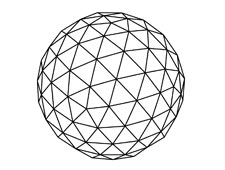Geodesic Domes
What is so special about a dome?
Geodesic domes are mathematical constructs, which allow a collection of flat triangles to approximate a spherical shape. To achieve this, a number of pentagons and hexagons appear in much the same way as on a football.

R Buckminster Fuller is credited with the popularization of the structure and the “geodesic” name in the late 1940s. The triangular elements of a dome are structurally rigid and distribute the structural stress throughout the structure, making geodesic domes extremely strong and stable for its weight. A sphere encloses the greatest volume for the least surface area.
Some of the most famous domes include the Montreal Biosphere, Spaceship Earth at the EPCOT Center and the giant Eden Project domes in Cornwall, UK
What about dome frequency?
In practice, geodesic domes become increasingly complex as their size increases. This complexity is known as the “frequency” (v) of the dome and effectively begins with a 2v (or 2-frequency) structure. For practical marquees, the 2v to 6v range addresses structures from 12ft to 60ft diameter.
A 2v dome has 2 different triangles, a 3v dome has 3 different triangles, etc.
To produce a hemispherical 2v dome requires 65 poles (of two lengths) and 26 junctions or “hubs”. Smaller domes from 4-7m are often made to this design.
Our mid-sized domes are made to a 3v design involving 120 poles and 46 hubs. We use slightly less than a hemisphere to allow the more economic use of canvas and less height for ease of construction. These domes range from 8 to 14m in diameter.
For domes 18m and upwards we use a 4v or 5v design.

1 frequency (1v)


2 frequency (2v)


3 frequency (3v)


4 frequency (4v)

